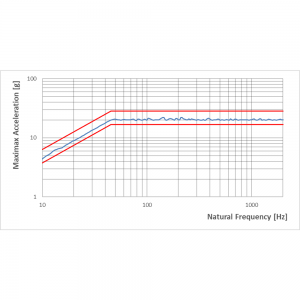SRS based shock testing is one of the most favourable option for defence applications due to its ability to replicate effects of complex real-life shocks under laboratory environment.
The amplitude of a Shock Response Spectrum is the peak vibration response versus frequency of a series of mass-spring-damper systems created during a shock or transient event. A Shock Response Spectrum (SRS) is a graphical presentation of a transient acceleration pulse’s potential to damage a structure. It plots the peak acceleration responses of a bank of single degree-of-freedom (SDOF) spring, mass damper systems all experiencing the same base-excitation as if on a rigid massless base. Each SDOF system has a different natural frequency; they all have the same viscous damping factor. A spectrum results from plotting the peak accelerations (vertically) against the natural frequencies (horizontally).
SRS Based Shock tests are specified in the Frequency Domain in terms of acceleration (G) vs. frequency (Hz) and typically are associated with high-g environments caused by severe impacts, explosive events, etc. SRS transient shocks incorporate a broad range of frequencies into the test pulse which better approximate the real mechanical event.
In addition to perform a shock test defined in SRS domain, TEKNO-ETA has the capability to perform all shock testing profiles with SRS conversion techniques and using MWSM for the systems that have relatively large mass and exceeds the limits of an electrodynamic shaker.
Testing Standards we can carry out:
- MIL-STD-810F Procedure I Functional Shock, Figure 516.5-8 Test SRS
- MIL-STD-810F Prodecure V Crash Hazard, Figure 516.5-8 Test SRS
- MIL-STD-810G Procedure I Functional Shock, Figure 516.6-8 Test SRS
- MIL-STD-810G Procedure V Crash Hazard, Figure 516.6-8 Test SRS
- MIL-STD-810G Change 1 Procedure I Functional Shock, Figure 516.7-9 Test SRS
- MIL-STD-810G Change 1 Procedure V Crash Hazard, Figure 516.7-9 Test SRS
- BV0430
- STANAG 4141
Please feel free to contact us for additional testing standards and applicability of your custom testing profiles.






